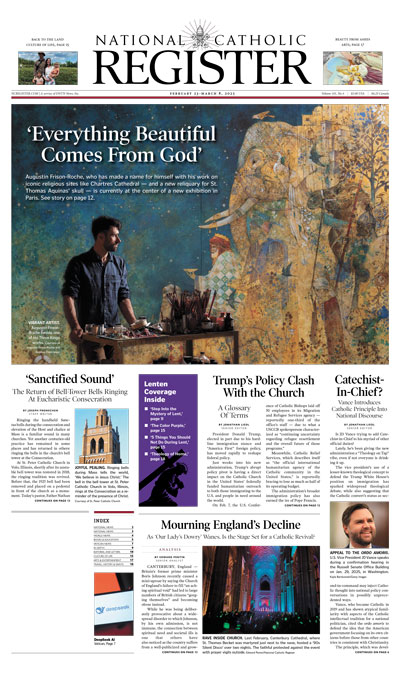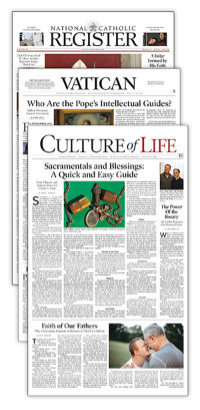What Is a Deacon?
EXPLAINER: Understanding the ministry of liturgy, word and charity.

It’s possible to define deacons in a number of ways — by their state in life, ministries, ordination, history or calling — but it’s a mistake to reduce them to the roles or functions. This may be why the ministry is poorly understood by many, who view them as either incomplete priests or tall altar boys. The charism of diakonia calls a man to be a visible sign of the connection between the liturgy and word and the Church’s own call to service.
As Los Angeles Archbishop José Gomez has explained, a deacon is “called to minister in persona Christi Servi — in the person of Christ the Servant. Ordination configures him to Jesus in his most humble form — as the Son of God who emptied himself to come among us in the form of a servant; as the Son of Man who came not to be served, but to serve.”
Approximately 19,000 deacons serve in the United States, which represents a significant portion (about 40%) of the estimated 50,450 worldwide. This makes them a very visible presence in the U.S., and as priestly vocations decline, these men are being asked to take on more responsibilities in their parishes. This weekend, as they gather for the Jubilee of Deacons in Rome, the Register offers an explainer.
In the Bible and Church History
Deacons first appear in Chapter 6 of the Acts of the Apostles as the seven men called to serve at table and “look after the accounts.” One of them, Stephen, goes forth preaching and performing miracles, whereupon he is stoned to death, becoming the Church’s first martyr.
The deacons were highly regarded by the Church Fathers, with St. Ignatius of Antioch writing that everyone should “revere the deacons as they would Jesus Christ.” They held the purse, tended to the needs of the poor and served their flocks in a unique way. As priests began to take on more of these roles, the role of the deacon began to decline, and by the early Middle Ages, it became merely a stage on the way to priestly ordination.
The diaconate was restored following the Second Vatican Council, with Lumen Gentium describing the imposition of hands “‘not unto the priesthood, but unto a ministry of service.’ For strengthened by sacramental grace, in communion with the bishop and his group of priests they serve in the diaconate of the liturgy, of the word, and of charity to the people of God.”
The Imposition of Hands
According to Pope St. Paul VI, in Sacrum Diaconatus Ordinem, it is “beneficial that those who perform a truly diaconal ministry be strengthened by the imposition of hands, a tradition going back to the Apostles, and be more closely joined to the altar so that they may more effectively carry out their ministry through the sacramental grace of the diaconate.”
The diaconate is the first degree of the sacrament of holy orders, followed by the presbyterate (priests) and episcopate (bishops). All deacons, priests and bishops are first called to the ministries (formerly part of the minor orders) of candidacy, lector and acolyte before receiving holy orders as deacons. After a period — usually one year — as a deacon (sometimes called a transitional deacon), a man may proceed to the second degree of holy orders and become a priest. Some men, however, are called to remain as deacons permanently, expressing the diaconal charism of ordination in a unique way.
These men, typically called permanent deacons, are usually married and have ordinary jobs and families. Though they remain immersed in family and professional life, their ordination grants them special graces to serve in the Church in a distinct way. During the Rite of Ordination, they do not take a vow of celibacy, but promise not to remarry if their wives predecease them.
Ordination usually follows a long period of discernment, theological education and pastoral formation, in some cases taking up to six years from inquiry to completion. Each bishop defines the process, and many prelates are requiring more rigorous training, including graduate degrees in theology and pastoral formation.
What Do Deacons Do?
Deacons cannot hear confessions, anoint the sick or confect the Eucharist. They can perform baptisms, witness and bless marriages and perform funeral rites other than a full Mass. They may also perform formal blessings, offer benediction and adoration, administer viaticum, proclaim the Gospel, preach homilies, serve at the altar, lead worship and prayer services, guide communities in the absence of a priest, administer charity, catechize, and serve the sick, grieving and needy.
Although they are most visible in their liturgical service, their duties often extend far beyond that, much of it unseen.

In Their Own Words
The best way to understand who a deacon is and what he does is from the men themselves.
“The deacon is a minister of evangelization, a permanent and ordained sign and witness of Christ’s ministry of service,” explained Deacon Harold Burke-Sivers, well-known author, speaker and EWTN Radio and Television series host known as the “Dynamic Deacon.”
“Through their service ministry, ordained deacons assist bishops with their responsibility of spreading the Gospel throughout the world, thus enhancing and strengthening the life of the Church,” he told the Register. “This service ministry models, with integrity and confidence, what it means to live an authentic Christian life. In short, deacons are sacramental signs of the Church in the world; they are consecrated and visible witness to the kingdom of God made manifest in Christ the Servant.”
Deacon John Italia, who serves St. Paul parish in Princeton, New Jersey, spoke to the Register about the unique privilege of his role: “It’s extremely rewarding to be the first point of contact someone has had with the Church in many years, especially when preparing couples for marriage or parents having their children baptized.”
“Deacons have a great opportunity to encourage, support and teach those wanting to practice their faith more fully,” he added. “The most impactful parts of my ministry are often what people don’t see. In the last week, I’ve fixed a parishioner’s doorbell, sat with someone in detox and helped coordinate the medical care for a trauma victim. Beyond routine hospital and homebound visits, I’m often involved with individuals in crisis who have no family to care for them. It may involve getting them to a hospital, advocating for them with an emergency team or making sure their medicine is available. When a parishioner in need reaches out for help or invites you as a partner on their faith journey, it’s always a humbling experience.”
Accompaniment is key, according to Deacon Bill Burns, from the Cathedral of St. John the Evangelist in the Diocese of Boise, Idaho.
“I work with couples preparing for the sacrament of matrimony, advocate for individuals petitioning for decrees of nullity, support and engage in charitable outreach ministries of various kinds, and assist in other sacramental preparation ministries like OCIA,” he explained to the Register. “Deacons also are described as having a foot in both worlds — with the clergy and with the laity. We are often the ones who take the needs of the faithful to the priests and bishops. Many deacons also provide spiritual direction.”
He emphasized, “It’s a great blessing to walk with people in every moment of their lives, even the most painful moments, in their times of sickness and loss. That is one of the reasons why I am pursuing a licentiate in canon law, which I hope to finish this summer.”
Register contributor Deacon Thomas L. McDonald serves at St. Mary of the Lakes parish in the Diocese of Trenton, New Jersey, where, in addition to his service at Mass, he is a catechist, part of the OCIA team, acts as spiritual director of the Legion of Mary, collaborates with his wife Elizabeth on marriage and baptismal preparation, and engages in hospital and bereavement ministry.
LEARN MORE VIA EWTN
- Keywords:
- catholic deacons
- holy orders
- church history
- diaconate

















